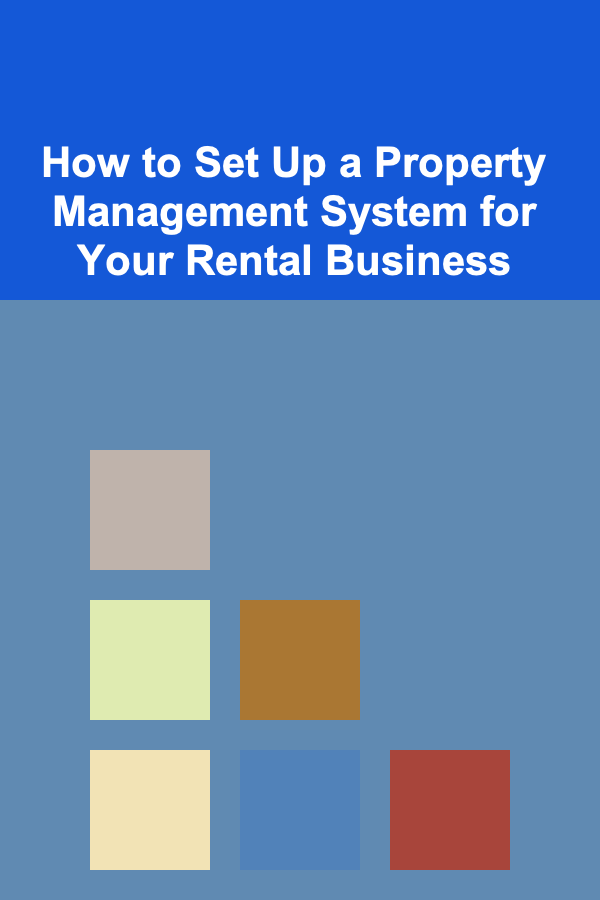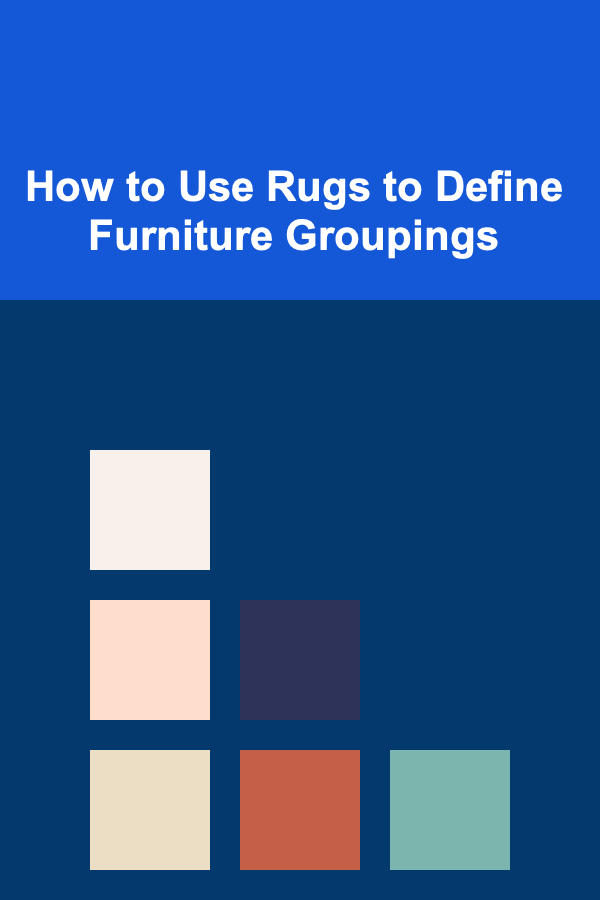
How to Set Up a Property Management System for Your Rental Business
ebook include PDF & Audio bundle (Micro Guide)
$12.99$9.99
Limited Time Offer! Order within the next:

Setting up an efficient property management system (PMS) is crucial for landlords and property managers looking to streamline their rental business operations. A well-organized PMS helps you handle everything from tenant communication to maintenance requests, rent collection, and financial management---all in one place. Whether you own a single rental unit or manage multiple properties, having an effective system in place can save you time, reduce stress, and improve overall tenant satisfaction.
In this article, we will walk you through the essential steps involved in setting up a property management system for your rental business, offering insights on how to automate routine tasks, organize your workflow, and leverage technology to enhance your operations.
Understanding the Importance of a Property Management System
Before diving into how to set up a property management system, it's important to understand why you need one in the first place. Property management encompasses a wide range of activities, all of which require careful tracking and organization. These activities include:
- Tenant and Lease Tracking: Managing lease agreements, tenant contact information, and renewal dates.
- Maintenance Management: Handling maintenance requests, repairs, and scheduled inspections.
- Rent Collection: Keeping track of rent payments, late fees, and payment history.
- Financial Management: Managing expenses, income, tax records, and other financial documentation.
- Communication: Staying in contact with tenants, contractors, and service providers.
Without a solid property management system, you risk inefficiencies and errors, which can lead to lost revenue, unhappy tenants, or legal complications. A good PMS ensures that all aspects of property management run smoothly and that you are compliant with relevant laws.
Benefits of a Property Management System
- Time Savings: Automating repetitive tasks such as rent collection and maintenance requests reduces the amount of manual effort required.
- Better Organization: Having a centralized platform to manage all your properties and tenant information helps you stay organized.
- Improved Tenant Relations: A PMS allows for better communication, faster response times, and streamlined maintenance, all of which lead to happier tenants.
- Financial Control: A PMS makes it easier to track income, expenses, and tax obligations, which improves your financial oversight.
- Compliance: A good PMS can help you stay compliant with local, state, and federal regulations, including rent control, fair housing laws, and health and safety requirements.
Key Components of a Property Management System
To set up a robust property management system, you need to incorporate the following core components:
1. Tenant and Lease Tracking
Effective tenant management starts with proper record-keeping. Your PMS should include a feature to store all tenant and lease information, including:
- Tenant contact details
- Lease start and end dates
- Rent amount and due dates
- Payment history and outstanding balances
- Lease renewals and amendments
A good PMS will help you avoid errors, such as forgetting a lease renewal or missing a rent payment. It will also give you quick access to tenant history, which can be useful when reviewing lease agreements or handling disputes.
2. Rent Collection and Payment Tracking
Rent collection is one of the most important tasks in property management. Your PMS should allow for automated rent reminders and online payment options. Features should include:
- Online Payment Processing: Allow tenants to pay their rent through a secure online portal.
- Late Payment Fees: Set up automatic late fees for missed payments and send reminders to tenants.
- Payment History: Track and store records of all payments made by tenants, including date, amount, and payment method.
Automating rent collection reduces the chances of missed or late payments, and it helps improve your cash flow by ensuring that payments are processed promptly.
3. Maintenance Management
Maintenance issues are bound to arise in any rental property, and how you handle them can significantly impact tenant satisfaction. A good PMS will include a maintenance management module that allows tenants to submit requests and track their resolution. Key features to look for include:
- Maintenance Request System: Tenants should be able to submit maintenance requests online through a tenant portal. The system should categorize and prioritize requests based on urgency.
- Service Provider Integration: A PMS that allows you to connect with third-party contractors or maintenance service providers can save you time when dispatching work orders.
- Tracking Progress: You should be able to track the progress of each maintenance request, ensuring that all issues are resolved within a reasonable timeframe.
Efficiently managing maintenance ensures that tenants feel cared for and reduces the risk of prolonged issues that could harm the property.
4. Financial Management and Reporting
Financial oversight is one of the biggest challenges for landlords. A good PMS should simplify your financial management by offering:
- Income and Expense Tracking: Track all rental income, maintenance costs, and other expenses to gain a clear picture of your property's profitability.
- Automated Billing and Invoicing: Automate the process of sending invoices for rent payments, late fees, and other charges.
- Tax Documentation: Many PMS solutions provide the option to generate tax reports, making it easier to file taxes at the end of the year.
Financial transparency helps you make better business decisions and stay on top of tax obligations.
5. Communication Tools
Effective communication is key to maintaining good landlord-tenant relationships. Your PMS should provide features that allow you to stay in contact with tenants, contractors, and other stakeholders:
- Tenant Messaging: Send messages directly to tenants about upcoming rent due dates, maintenance schedules, or property announcements.
- Tenant Portal: A portal where tenants can access lease documents, make payments, submit maintenance requests, and view account balances.
- Automated Notifications: Set up automated notifications for tenants regarding important updates or actions they need to take.
Good communication fosters positive relationships with tenants, which leads to lower turnover and better retention.
6. Document Storage and Management
Keeping all your documents organized and accessible is a critical part of managing rental properties. Your PMS should offer a secure document management feature that allows you to store and access key documents, such as:
- Lease agreements
- Inspection reports
- Maintenance receipts
- Tax documents
Cloud-based document storage ensures that all your records are securely stored and can be easily accessed when needed.
Steps to Set Up Your Property Management System
Step 1: Choose the Right Property Management Software
Selecting the right property management software is the first step toward setting up your PMS. You'll want a solution that meets the specific needs of your rental business. Look for software that offers the features outlined above and fits within your budget. Some popular property management software options include:
- AppFolio
- Buildium
- TenantCloud
- Yardi Voyager
- Rentec Direct
Many software providers offer free trials or demo versions, which allows you to explore their features before making a commitment.
Step 2: Set Up Tenant and Lease Information
Once you have chosen your software, the next step is to input tenant and lease information into the system. This includes:
- Adding tenant names, contact information, and move-in dates
- Inputting lease start and end dates, rent amounts, and payment due dates
- Setting up lease terms, renewal dates, and any special conditions or agreements
This is the foundation of your PMS, so it's important to ensure that all data is accurate and up to date.
Step 3: Automate Rent Collection and Set Payment Schedules
Setting up automated rent collection can save you a significant amount of time and effort. Configure your PMS to automatically send out rent reminders, generate invoices, and process online payments. You can also set up automatic late fees for overdue payments.
For properties with multiple tenants, automation ensures that all rent payments are collected on time, reducing the risk of late or missed payments.
Step 4: Organize Maintenance Requests
Set up a system for managing maintenance requests and tracking their resolution. Create a process for tenants to submit requests, assign priority levels, and ensure that maintenance issues are handled promptly. If applicable, connect your PMS with third-party service providers who can handle repairs or maintenance tasks.
Step 5: Establish Financial Tracking and Reporting
Set up your financial tracking system to monitor rental income, expenses, and profits. Ensure that you can generate reports for taxes, monthly income, and annual expenses. If your software offers budgeting tools, take advantage of them to create a detailed financial plan for your properties.
Step 6: Stay Compliant with Regulations
Ensure that your PMS complies with local and state regulations regarding tenant rights, rent control, and housing laws. Many property management systems come with built-in compliance tools to help you stay up to date with changes in legislation.
Step 7: Review and Optimize
Once your PMS is set up, regularly review your system to ensure that it's running smoothly. Look for opportunities to optimize processes, such as automating more tasks or improving tenant communication. Continuously refine your property management practices to ensure maximum efficiency.
Conclusion
Setting up a property management system is an essential step in running a successful rental business. By incorporating tenant tracking, rent collection, maintenance management, financial reporting, and effective communication tools, you can streamline your operations, improve tenant satisfaction, and grow your business with ease. Investing in the right software and creating a structured system for your rental business will provide long-term benefits, allowing you to focus on scaling your property portfolio while keeping operations running smoothly.
Reading More From Our Other Websites
- [Organization Tip 101] How to Develop a Study Plan for Each Subject
- [Home Staging 101] How to Market Your Home Staging Business to Attract High-Paying Clients
- [Organization Tip 101] How to Save Money with Smart Thermostat Installation
- [Organization Tip 101] How to Reflect on the Importance of a Balanced Wellness Space
- [Needle Felting Tip 101] Eco-Friendly Needle Felting: Using Sustainable Fibers and Recycled Materials
- [Whitewater Rafting Tip 101] Flow State on the River: Harnessing Rafting for Stress Relief and Mindfulness
- [Home Staging 101] How to Stage Your Home's Master Bedroom for a Relaxing Atmosphere
- [Personal Investment 101] How to Invest in Bonds to Generate Steady Income Streams
- [Organization Tip 101] How to Store Weights Safely and Accessibly
- [Home Lighting 101] How to Light a Sunroom for Bright, Natural Vibes

Finding Remote Work While Traveling: Tips for Digital Nomads
Read More
How to Create a Checklist for Reducing Sugar Intake
Read More
How to Create a Lease Agreement That Protects Both You and Your Tenants
Read More
How to Create a Rotating Display for Seasonal Collections
Read More
How to Use Rugs to Define Furniture Groupings
Read More
Selecting the Best Piping Bags and Tips for Cake Decorating
Read MoreOther Products

Finding Remote Work While Traveling: Tips for Digital Nomads
Read More
How to Create a Checklist for Reducing Sugar Intake
Read More
How to Create a Lease Agreement That Protects Both You and Your Tenants
Read More
How to Create a Rotating Display for Seasonal Collections
Read More
How to Use Rugs to Define Furniture Groupings
Read More